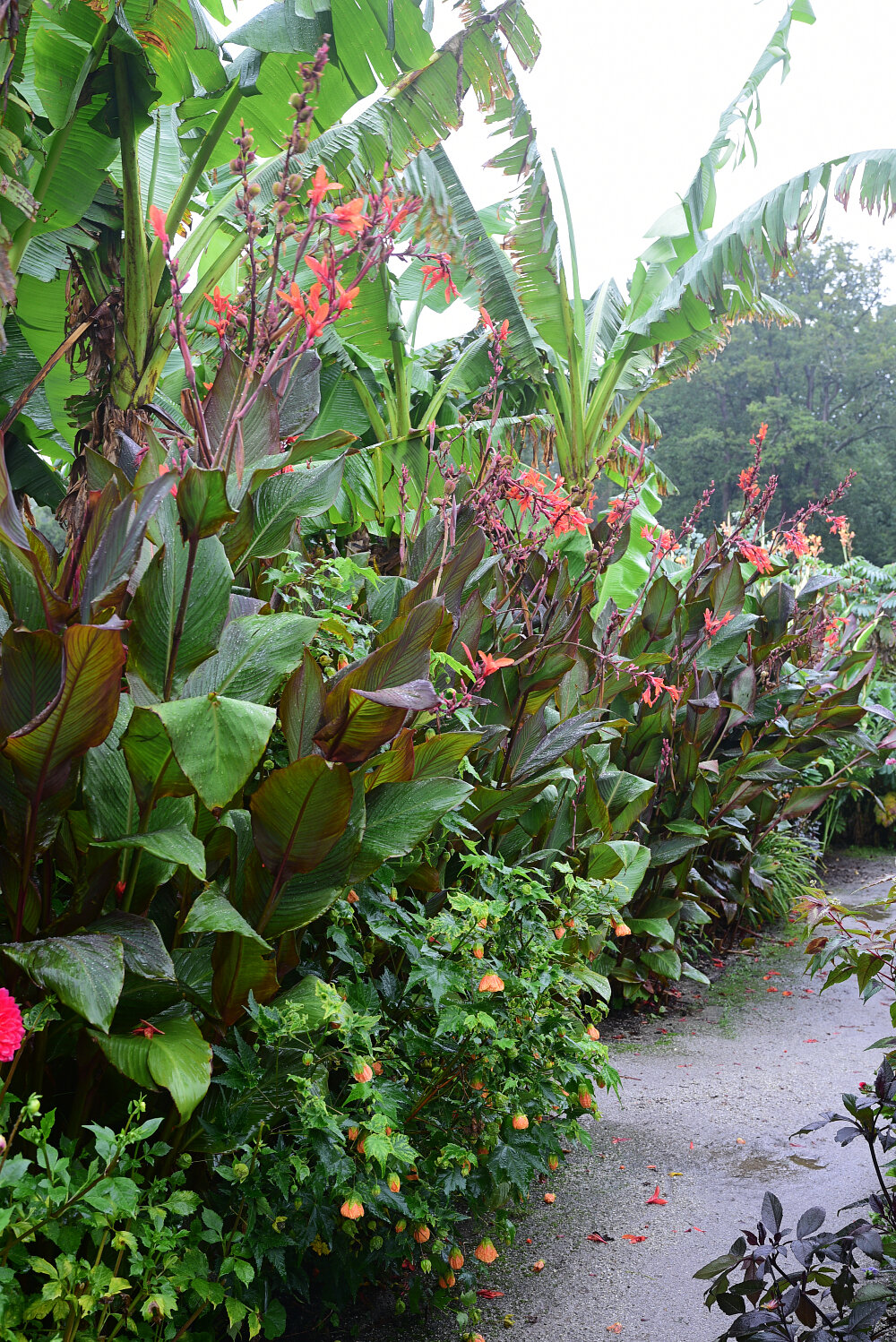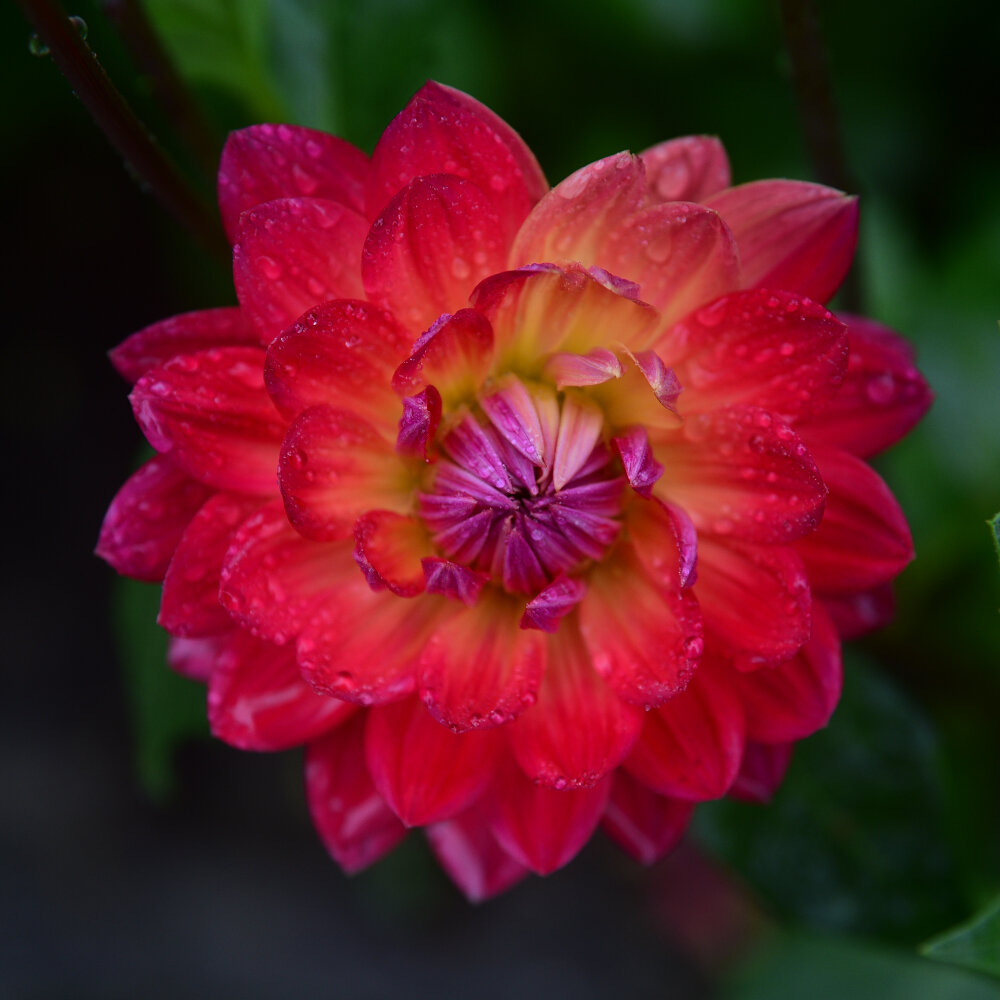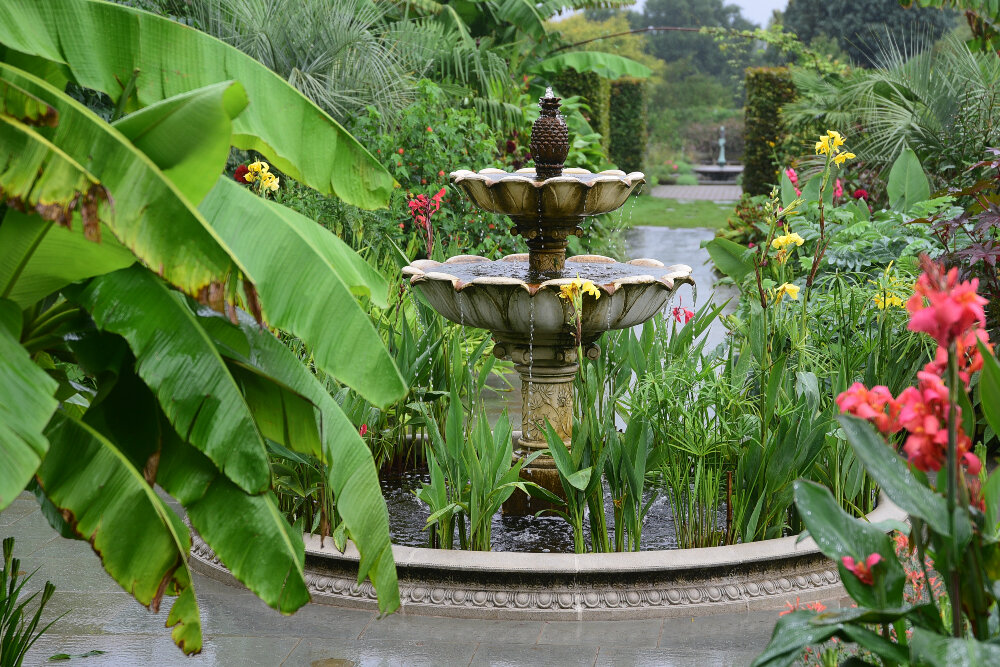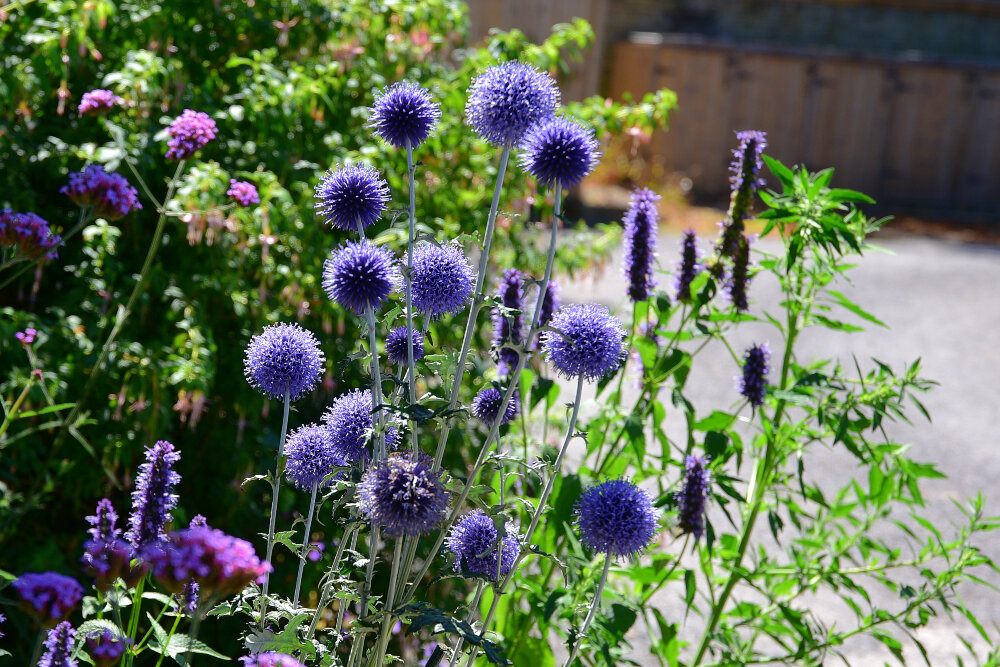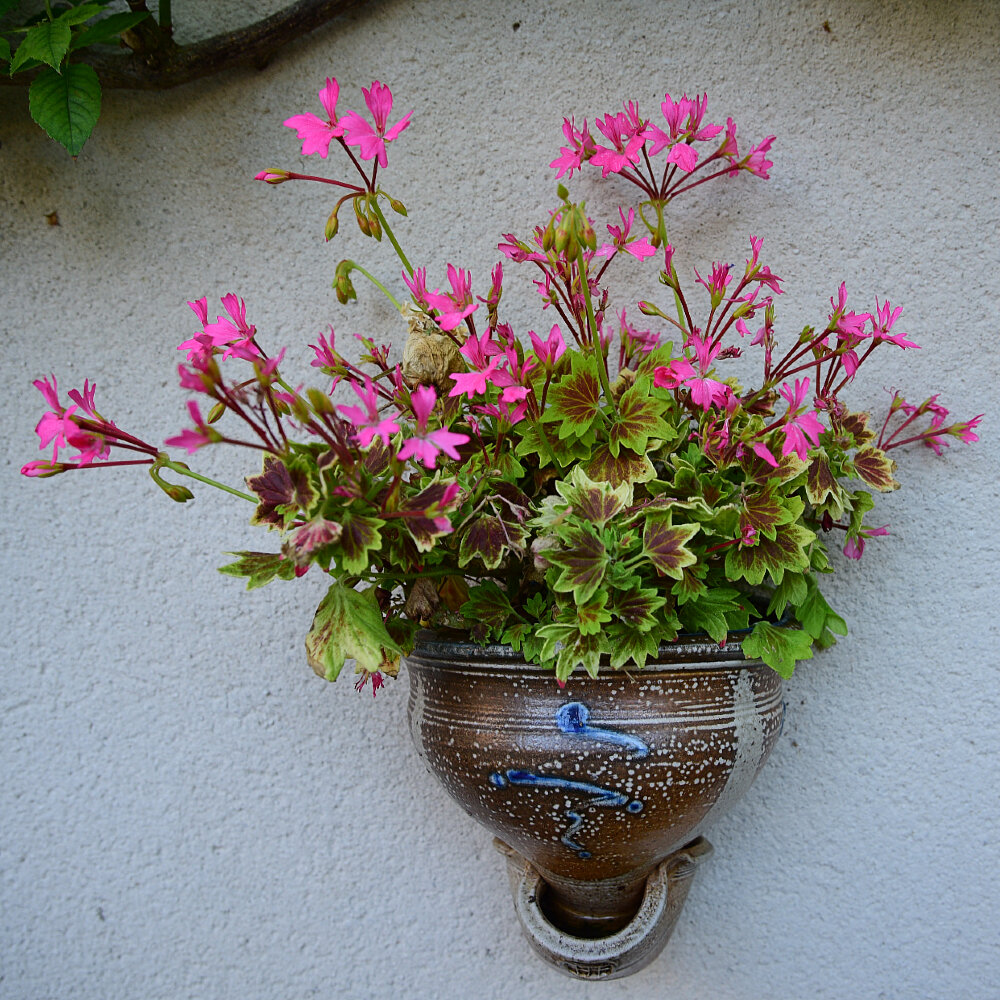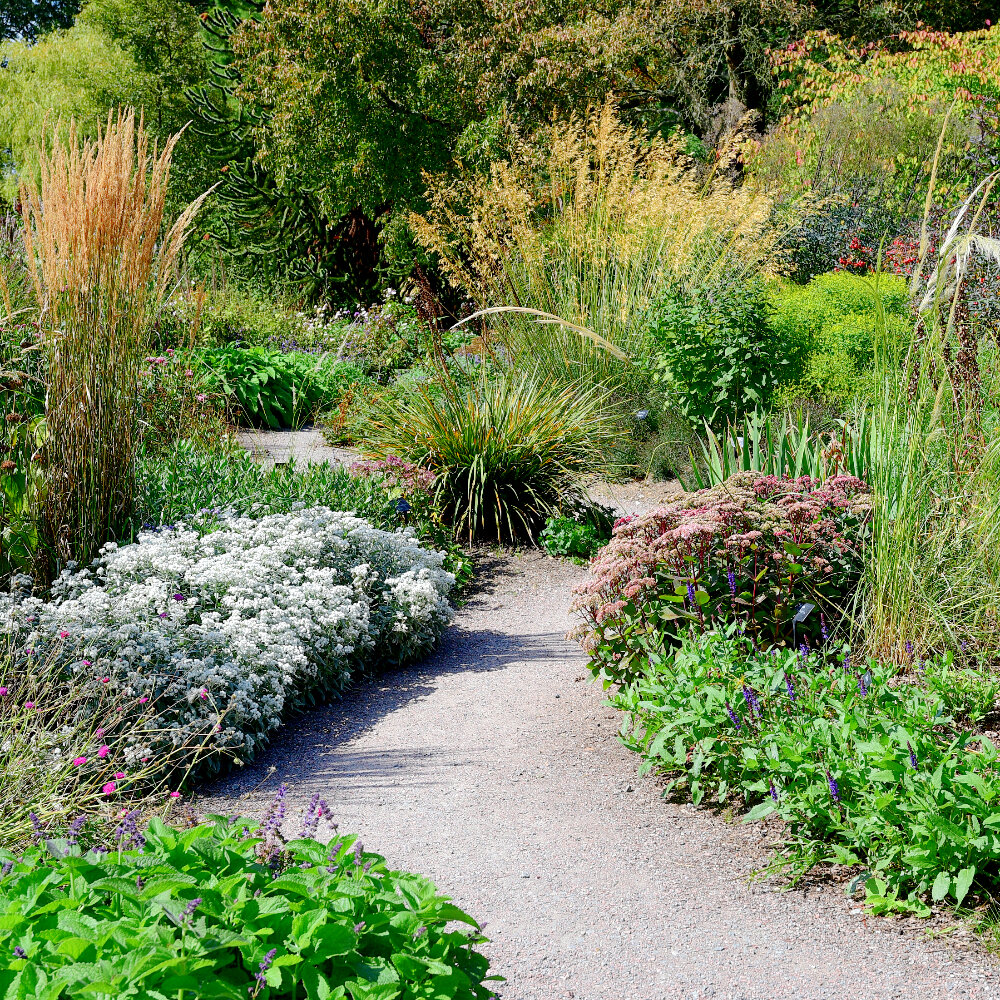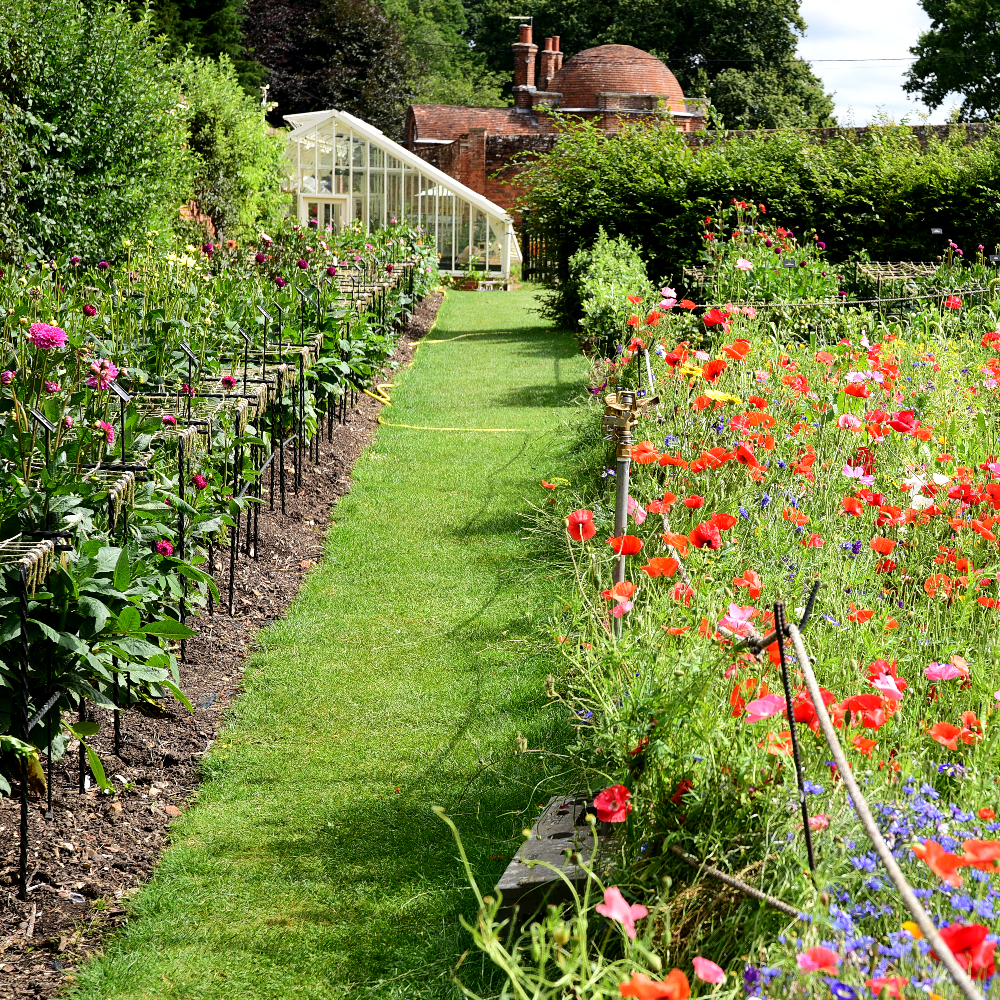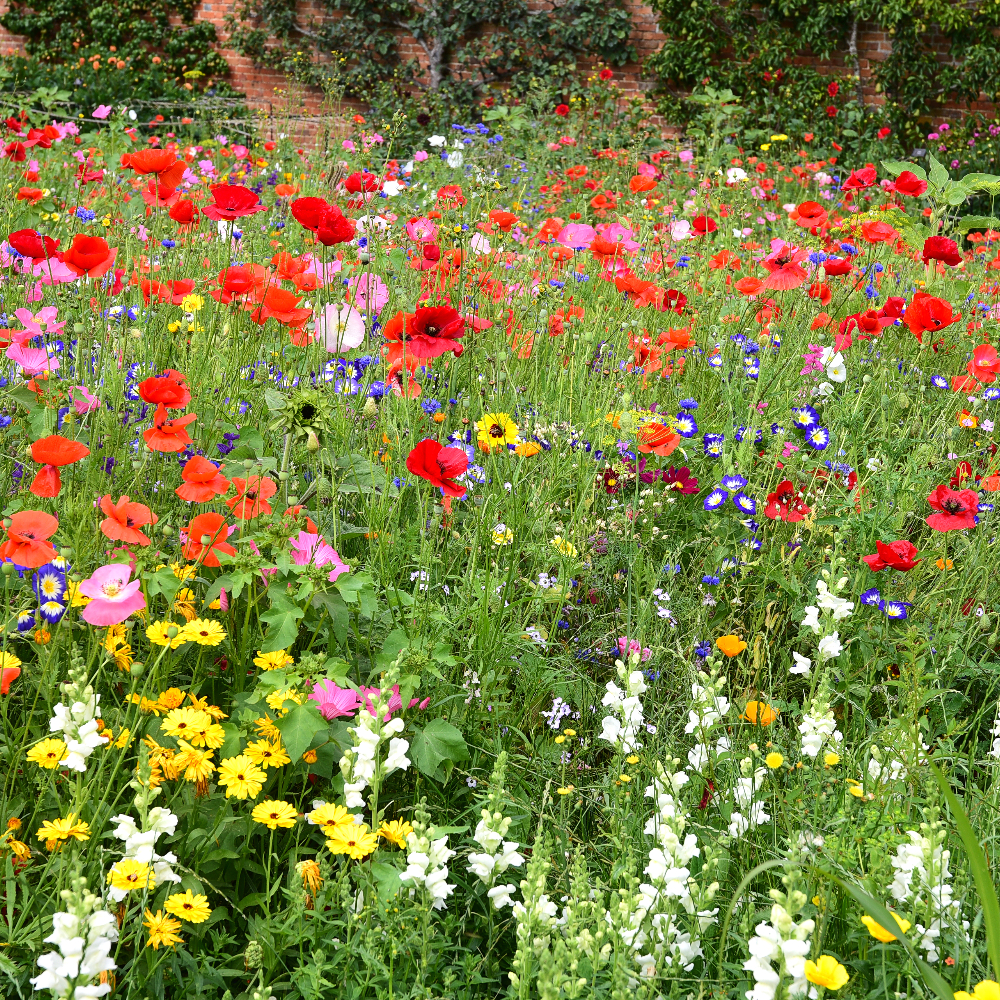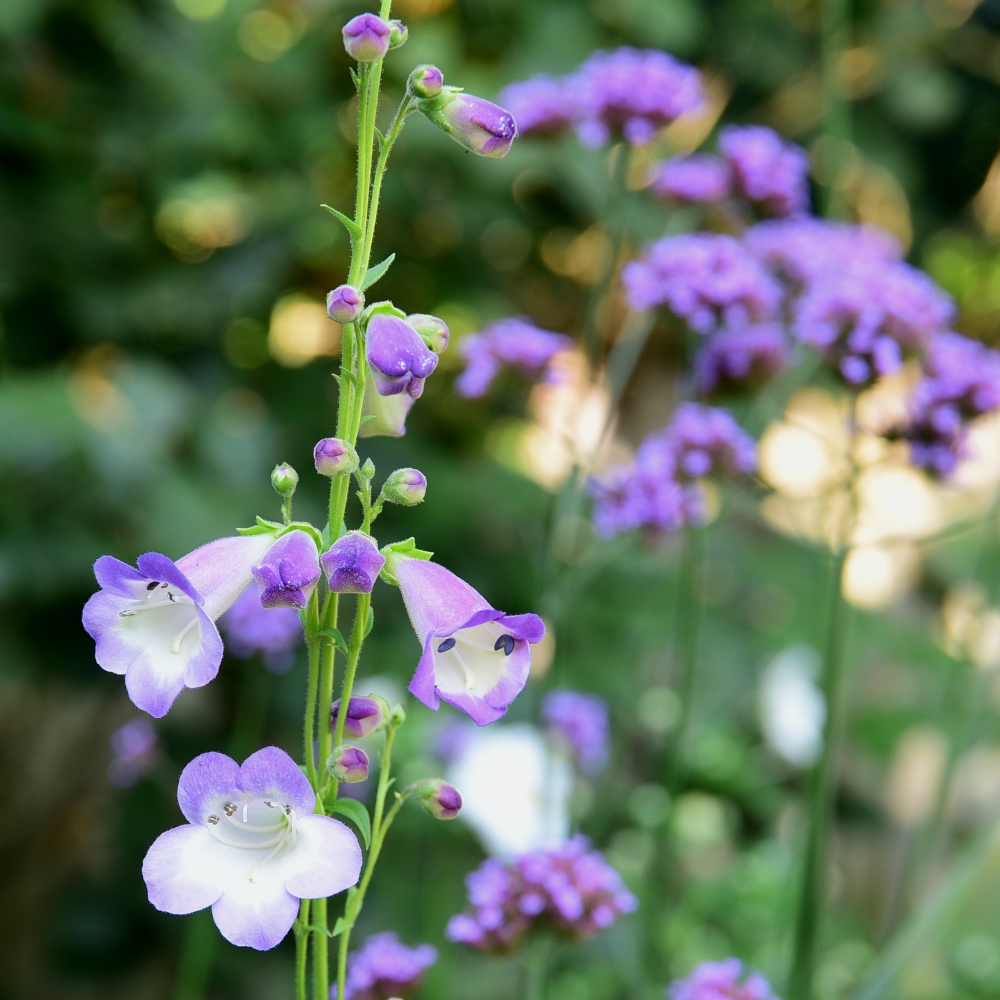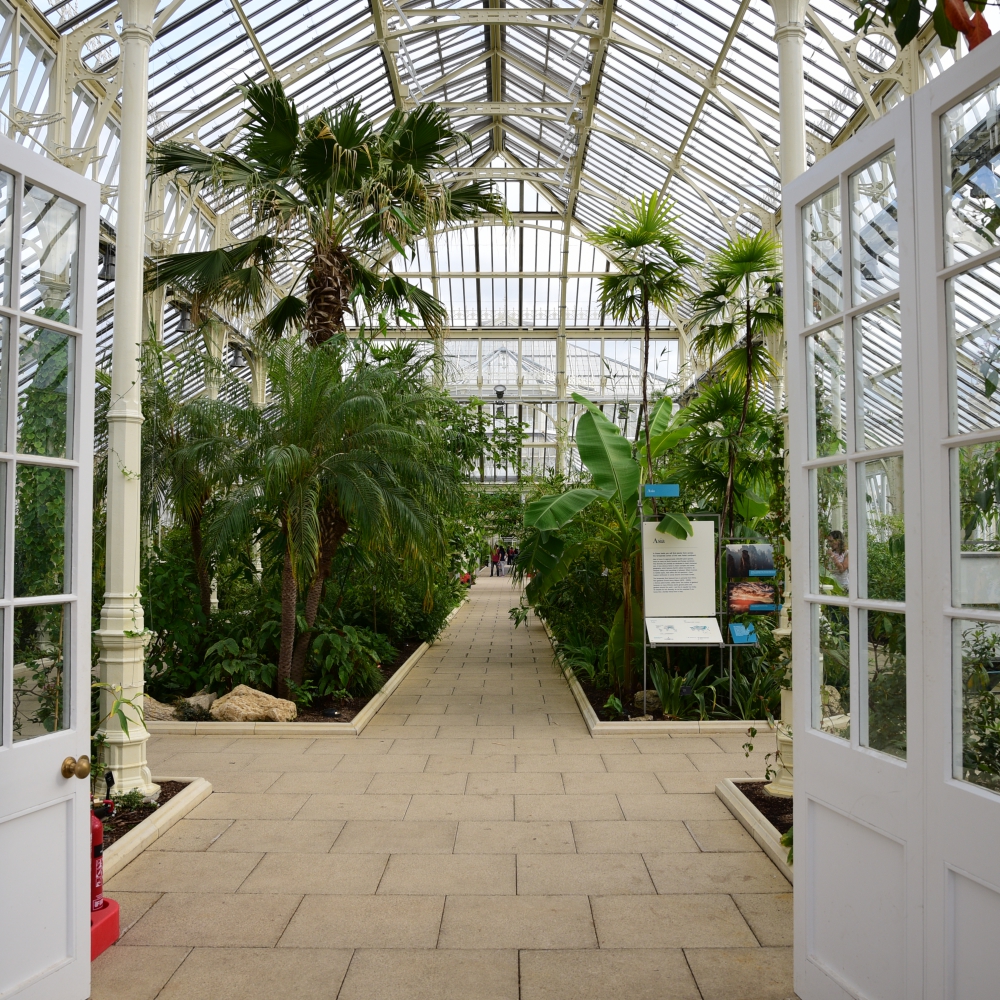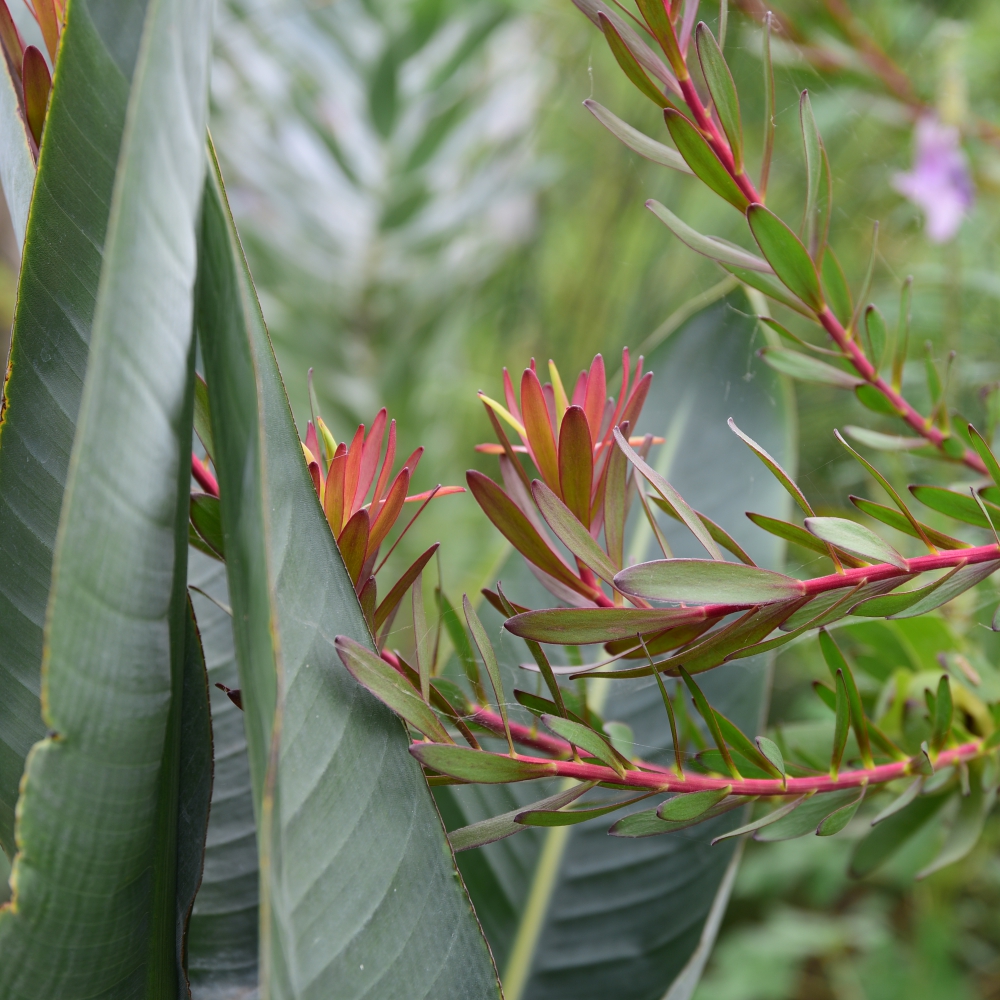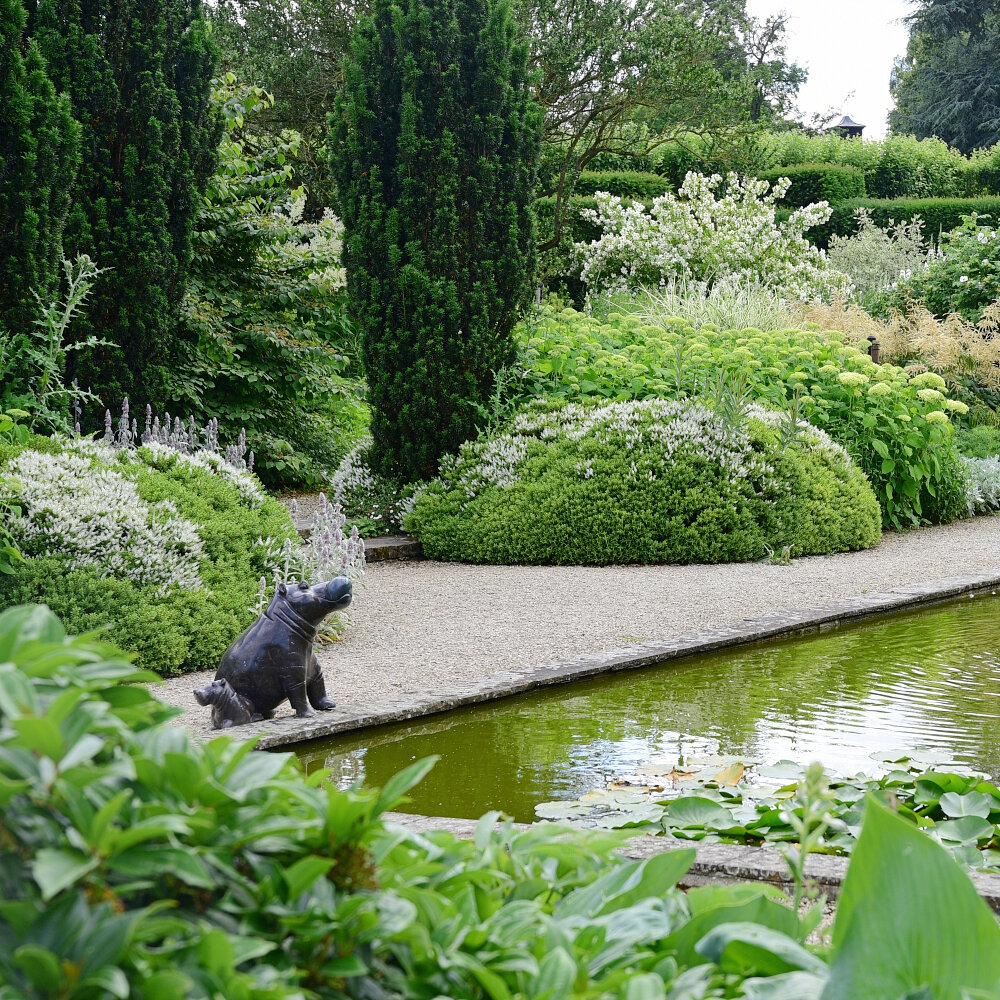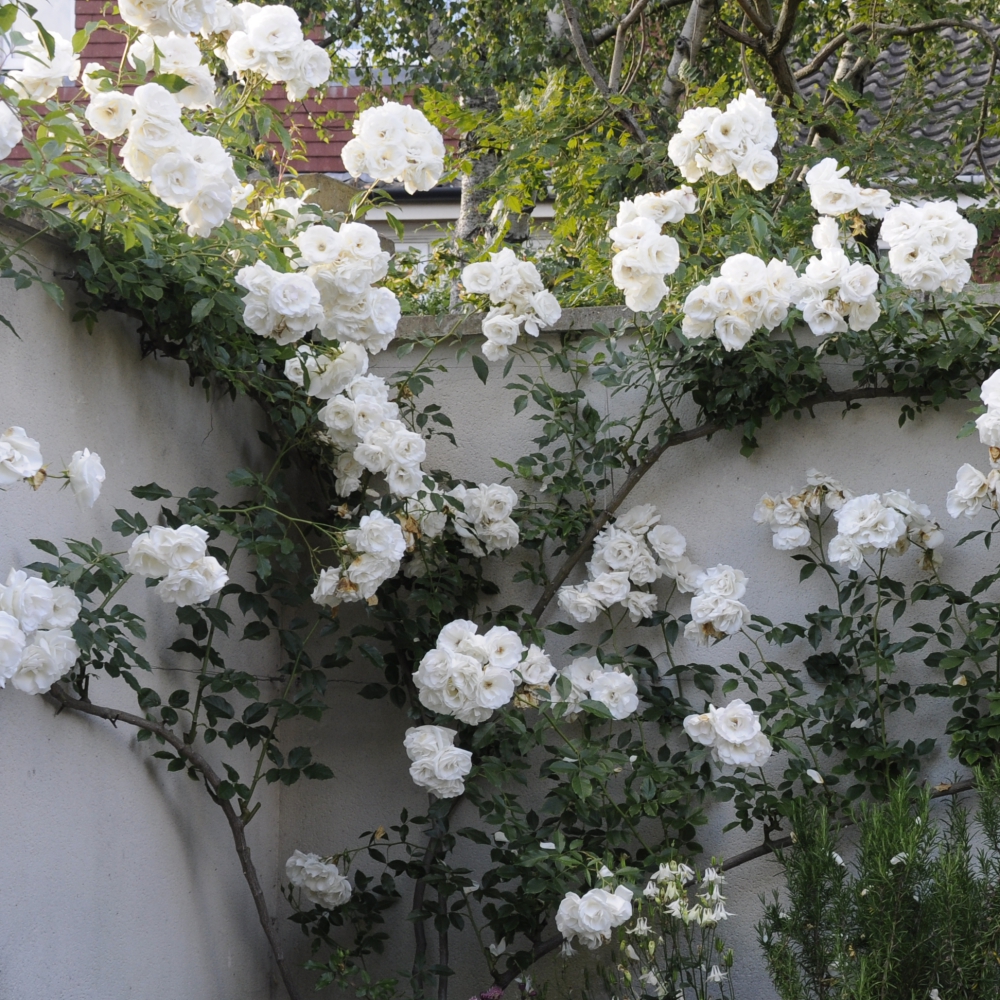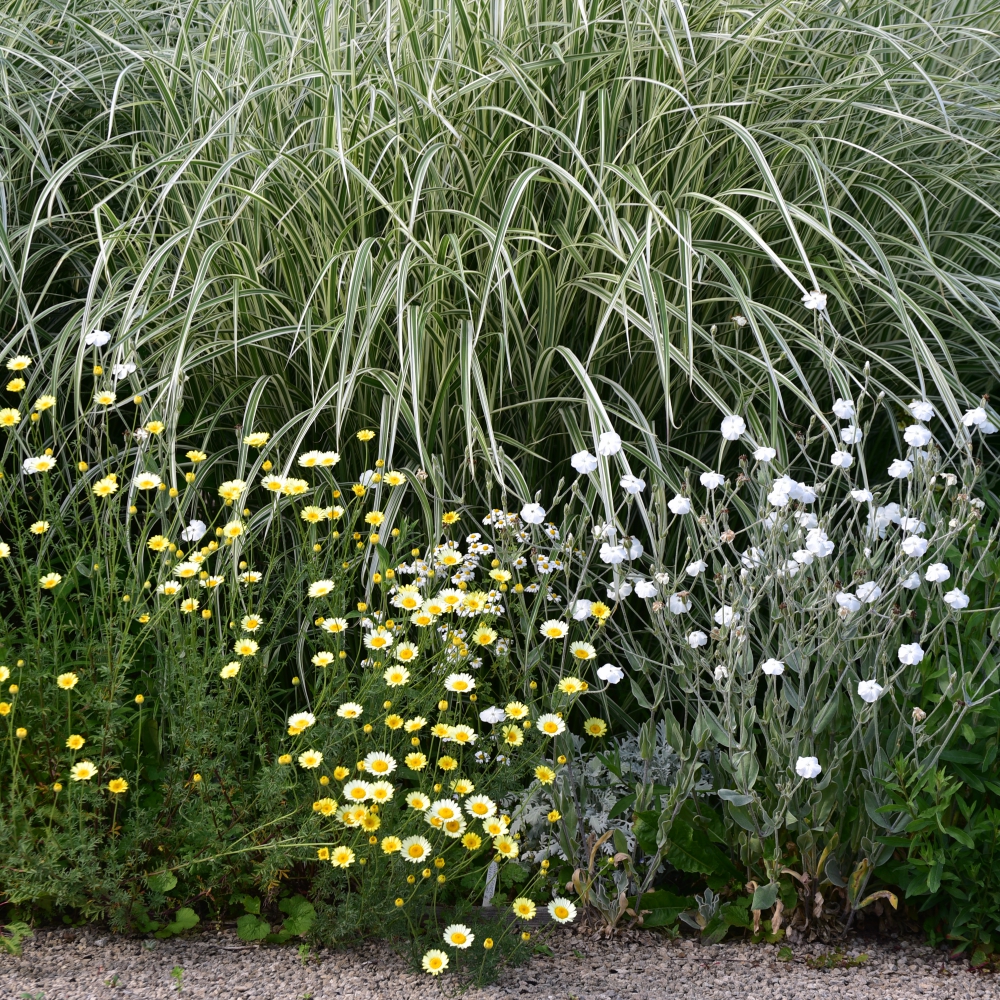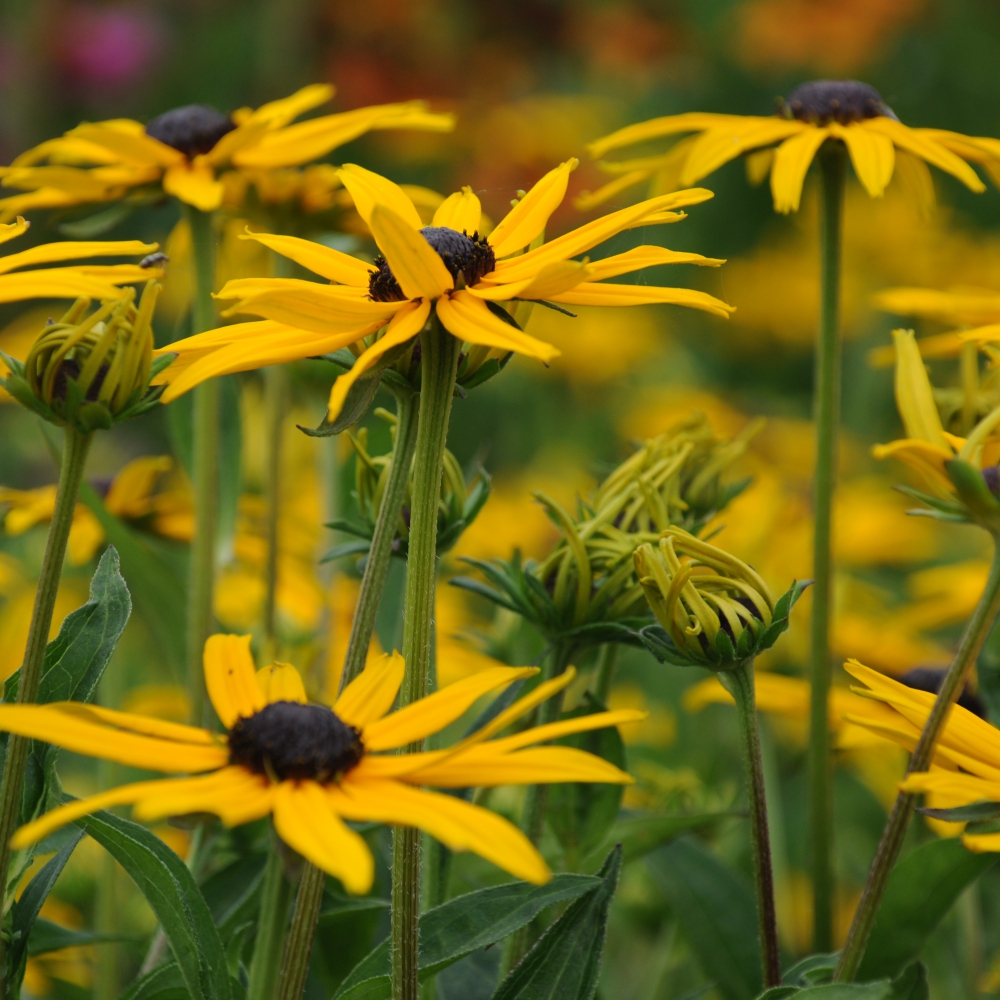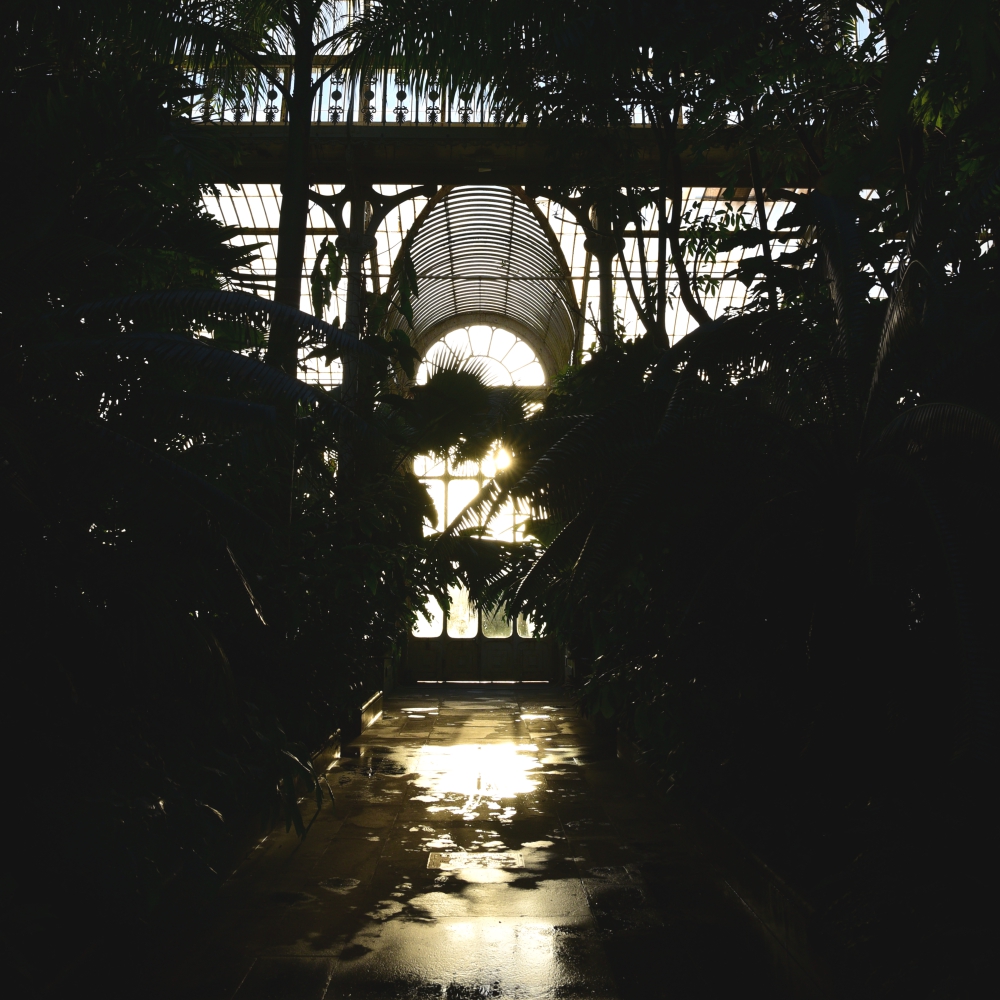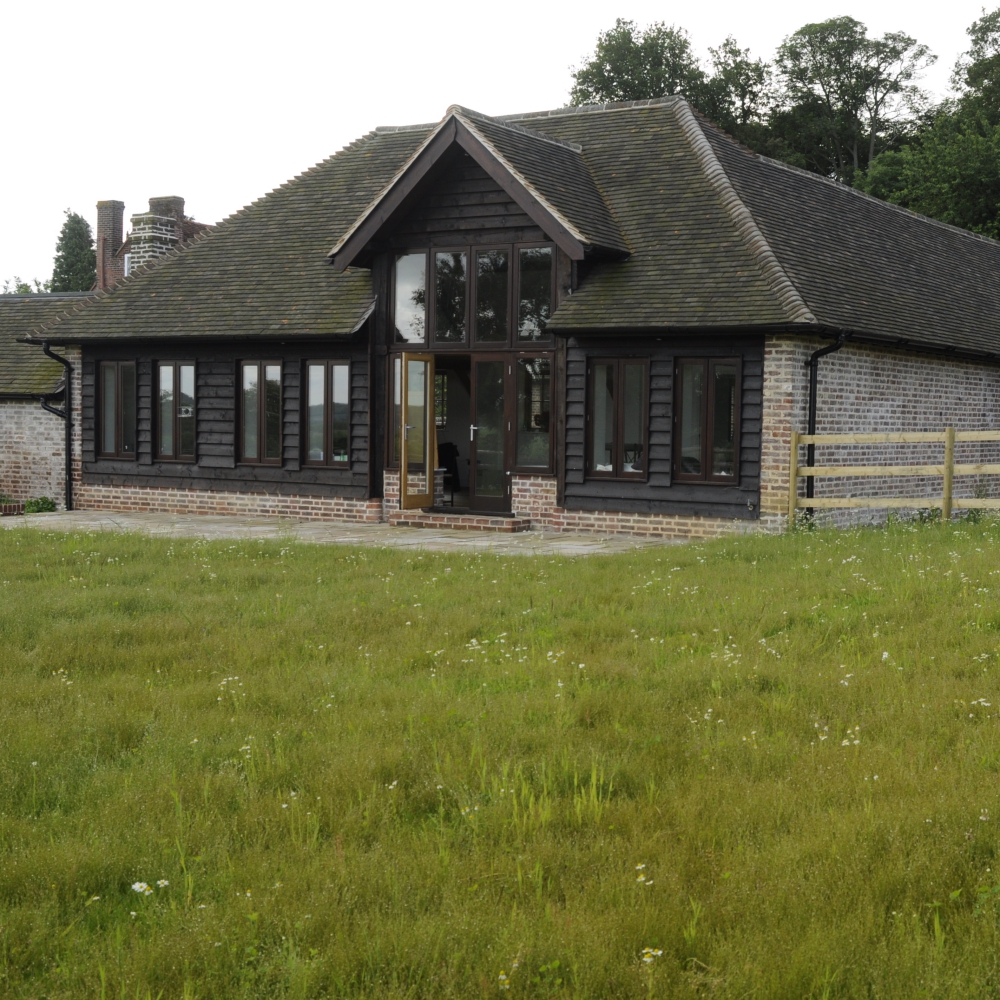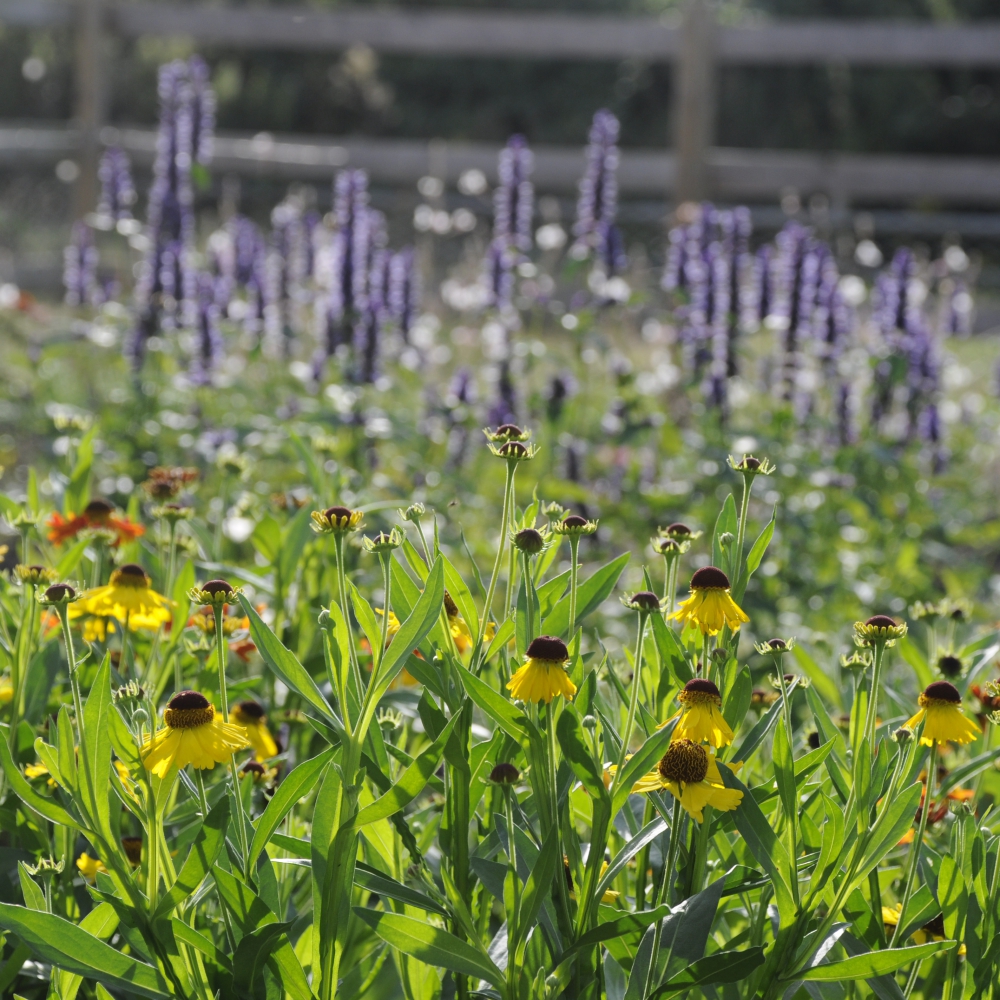Le Chateau du Lude
On a short holiday in the Loire region of France I convinced myself there must still be a hidden gem of a garden that I hadn’t visited.
Le Chateua du Lude
Having done Villandry, Chaumont and Chenonceau I had to travel north to the banks of the other Loire valley river, Le Loir, and Le Chateau Du Lude.
Rose Garden
Le Lude is the most northerly château of the Loire Valley and has been inhabited by the same family for the last 260 years. The gardens have evolved to combine French design and an English-style landscape, with a rose garden, topiary, a labyrinth and a botanical walk. And an unpublicised organic kitchen garden.
Lower Garden
The lower garden running along the river, was the original vegetable garden. This was moved further away to create a romantic French-style garden designed by Edouard André a renowned landscaper in the 19th century. Parterres of flowers and ponds succeed each other, with scented flowering shrubs like chimonanthus, lilac, philadelphus and calycanthus along the wall.
The fields opposite were planted as a landscape park.
Lily pond in Lower Garden
The spring garden is full of early perennials but these were mostly over at the time of my visit in June.
Fountain in Lower Garden
Le Loir from under a copper beech
So far, so French. Not too much in the way of flowers or colour after the slightly past-it rose garden. And then I noted there was a kitchen garden.
The Kitchen Garden
It was midday as I arrived as the gardener was locking the gates to the obviously “prive” kitchen garden. Somewhat crestfallen I mustered a smattering of pidgin French to explain I was a garden designer and just wanted some photos. Eager to get to his lunch he opened the gate for me and asked me to lock it when I was finshed. I can’t imagine the National Trust doing that.
A mixture of flowers and fruit and weeds, well it is organic..
Fruit trees in the Kitchen Garden
Sisyrinchium striatum, phlox and California poppies
Orangery, used as a tool store
The Kitchen Garden was the most floriferous part of the gardens, the informality of the planting here is in stark contrast to the more formal areas elsewhere.
Birdbox in the kitchen garden
I would say the garden at Le Chateau du Lude wasn’t quite the hidden gem I was hoping for. Having said that I spent a pleasant couple of hours here. It’s not as busy as all the better known gardens in the Loire and I was grateful for that. There are no refreshments available so you’ll need to bring your own. And, of course, it’s not open at lunchtime…
Website https://www.lelude.com/en/
Dahlia mania - the Exotic Garden at Wisley
On the wettest August day in a long time I thought it would be a good idea to visit RHS Wisley. How wet could it be I thought …
The Glasshouse Borders were looking windswept and the Long Borders were a little past their best but the Exotic Garden was still looking on top form.
The big leaves, bright colours and lushness of the Exotic Garden reminded me a little bit of Barbados. Even the rain added to the atmosphere. Here, the huge leaves of bananas and Cannas provide the jungly backdrop to the brightly coloured Canna flowers and the slightly more delicate and papery bells of orange Abutilon flowers.
Cannas are hungry plants and need to be well-fed and watered through the growing season. In milder areas you can keep them in the ground through winter. The flowers are pretty showy but it’s the leaves I really like. Often they are striped and multi-coloured.
The most recognisable highlights of the Exotic Garden though are the Dahlias. There were dozens of different varieties dotted around, however, very few of them were named - not very RHS I thought.
Many of you will know that Dahlias are enjoying a resurgence in popularity after years in the doldrums. Originating in Mexico they are relatively easy to grow in the UK if you follow a few simple rules. They make excellent flowers for cutting.
Dahlias prefer rich, free draining soils so if you’re gardening on heavy, unimproved clay you’ll need to lift them after the first frost. When planting new ones make sure it’s after the last frost of spring.
Many Dahlias have very large flowers and/or can reach heights of six feet. In these cases they’ll need staking - do it sooner rather than later.
Dahlias really benefit from regular feeding - you can use diluted tomato food twice a week. And dead-heading prolongs flowering.
The flowers come in lots of different colours and shapes. The National Dahlia Society has 14 different flower shape types (including miscellaneous). Generally, the simpler the shape the better the flower is for pollinators.
Dahlias can be prone to attacks from slugs and snails just as they are getting going and later from aphids and earwigs so keep an eye out for them.
Most people find them a delight to grow and their sheer exhuberance makes them the highlight of late summer and early autumn.
RHS Wisley is open every day and generally you have to book a timed entry. However, as the day I went was so wet many people had cancelled and I was able to get in without booking. I did call first to check though.
The shopping and catering facilities have increased vastly since my last visit (as has the size of the carpark - be prepared to walk upto a couple of hundred yards just to get to the entrance).
By the way, the rain stopped just before it closed, pretty wet then.
Readers' Gardens August 2020
Amanda and Matt
Amanda and Matt’s large back garden near Wimbledon Common was completely replanted in the autumn of 2017. It has matured really nicely and most of the plants have done well. You can see how it used to look here .
In late summer there are a lot of oranges, from Helenium Waldtraut here, and darker rusts from the old flower spikes of foxgloves and the new flower spikes of the grass Calamagrostis x acutiflora Karl Foerster.
These are contrasted with the cooler blues of the long flowering Geranium Rozanne and fading Stachys officinalis Hummelo. One plant that hasn’t done well here is my favourite echinacea, E. pallida, and we’re now looking for something dusty pink to replace it.
Amanda and Matt’s garden is abuzz with pollinators at this time of year, and two of their favourites are these Veronicastrum and Vebena bonariensis. If you’re looking for something tall and late to fill the back of a sunny border you can’t really go wrong with these two.
Rupert
Across Wimbledon to a trendy apartment with its own garden. The front garden overlooks a shared driveway and Rupert wanted to improve the outlook from the kitchen window as well as the approach to the front door.
We had to do a fair amount of editing of existing plants and not a small amount of weeding. Some of the existing shrubs, like this mature Hibiscus, were definitely worth saving.
The border is south-facing and is hot and sunny all through the summer, perfect for these Echinacea purpurea Magnus.
Most of the flowers like these Echinops and Agastache are attractive to pollinators and the border was buzzing on a hot day in late July.
Like most planting schemes some minor adjustments are required after a couple of years and Rupert is keen to add some dark red to the border, something I’ll be helping him with soon.
South Park Gardens
Ok, so not strictly a reader’s garden, but my local park, South Park Gardens, where I have been volunteering since the start of lockdown. The council provides gardeners to mow the lawns, tend the trees, deal with the litter and plant up the traditional bedding in the centre of the park.
The main decorative borders are tended by a team of volunteers lead by super-volunteer Rachel. Most of our gardening efforts have been focused on weeding, but Rachel has also taken charge of quite a bit of new planting, most of which has required a lot of watering in it’s first year.
In these “extraordinary times” the park has seen a lot more use than usual. It’s always been popular with young families but this year has seen an exponential increase in use by all sorts of people - joggers, cyclists, dog-walkers, slack-liners, birthday parties and other celebrations, and has been the focus of many local residents' get togethers in a relatively safe outdoor environment.
On the one hand this has meant that all our efforts head down in the borders have been truly appreciated. We often get nice comments about how good the park looks and how much people enjoy spending time in it. On the other hand there has been an astronomical increase in the amount of litter in the park, some trees and shrubs have been damaged by people climbing them and the watering points have been turned on and left several times.
Overall though the whole volunteering experience has been much more positive than I expected. I’ve got to know many more neighbours, there’s the perk of the occasional bunch of cut flowers from the gardeners’ compound and the odd free coffee from the kiosk Bliss in the Park (courtesy of the Friends of South Park Gardens who also fund the plant purchases).
I’ll carry on with the volunteering for the time being. Many thanks to all the other volunteers - Rachel, Helen, Jane, Mike, Will, Regina, another Rachel and another Helen, Nushi,and anyone I’ve accidentally forgotten.
To see more of South Park Gardens click here
Readers' Gardens July 2020
Glenis
Glenis and I have been collaborating on her garden since she moved into the new build in south west London in 2008. Amazingly, it is completely walled. This Rosa Iceberg didn’t do very well in the first year and Glenis took some persuading to keep it for another year. But since then it has flowered prolifically and does a great job filling this corner.
Like many of my clients who have lived in hot countries Glenis likes lots of colour and so the subtle palette of blues and yellows that I started with have gradually got hotter and brighter. We don’t know the variety of these orange Alstromerias but with regular dead-heading they flower most of the summer.
Some of the blues remain though and these Campanula porscharskyana Stella carpet one of the borders.
Glenis is a big fan of planters and is assiduous in watering, feeding and dead-heading them. She has a small collection of these pretty wall-hung pots planted with pelargoniums, ideal for keeping busy in lock-down.
Inger and Peter
Inger and Peter have got a lovely large, private garden in Wimbledon. This is its fourth summer and has really filled out. It’s quite shady due to the large trees in the garden, many of which are protected. In summer though there is a lot of sun and this table and chairs are perfectly placed for a morning coffee.
In the second half of the summer these Hydrangea macrophylla Mme Emilie Moulliere are the stars of the garden. They start off a brilliant white and fade to a lovely pink by the end of summer.
Accompanying the hydrangeas are spots of pink and blue. These Geranium Mrs Kendall Clark have thrived in the rain this June.
A dining table, flanked by Olive trees and Erigeron karvinskianus, is handily placed between the kitchen and the orangery. You can see more of this garden here - https://www.arthurroadlandscapes.co.uk/designs#/wimbledon-common-garden/
My garden
A slight lack of planning means that I’ve run out of readers’ gardens and so have to resort to using my own. Like many people I’ve spent a lot more time in my garden than usual which means it does look a bit better than usual. The weather’s helped too.
As a garden designer I find my self being caught between the endless possibilities of what I could do, what I actually have the time and money to do, and finding homes for random plants that have proved surplus to requirements in clients’ gardens.
One end of the garden is my attempt at a white garden. It’s been fairly successful so far with some pale pink and pale yellow in it as well. At the other end is a mix of blue and white and yellow but I can’t decide if the purple blob of Berberis in the middle is a good thing or bad thing.
And just in case you were wondering about the shockingly long grass … it was an experiement to see what would happen if I didn’t mow it. The result? Very long grass (no wildflowers/weeds whatsoever) that my camera shy cat likes playing in.
Thank goodness most public gardens are now open.
8 Easy ways to "green up" your garden
New year, new resolutions? You can’t have seen any of the news recently and wondered how on earth you could really make any difference to your environment. This might help; doing just one of these is something.
The two best things you can to green up your garden are to reduce inputs and outputs - water, fertilizer, compost, plastic, pesticides and increase bio-diversity - grow more, encourage wildlife, be less tidy.
1 - Get a water butt
I know, this isn’t going to eliminate the need for running a hose in your garden, especially given how hot recent summers have been here in London. But, 350 litres of water, filled several times by torrential downpours, will make a difference. And they’re not all unattractive and they are also pretty easy to install.
2 - Make your own fertilizer
You’ve seen this plenty of times on Gardener’s World - steep comfrey leaves in water for a few weeks. You know it’s done when the smell gets really bad, then water your tomatoes and flowers with it. And get or make a compost bin.
3 - Mulch
What to do with all those autumn leaves? Collect them and store them in bags with a few holes, or wire cages. The resulting compost can be spread on your flowerbeds in spring. This helps keep down weeds, improves the texture of your soil (especially clay) and reduces the need for watering.
4 - Recyclable plant pots
As you probably know black plastic plant pots can’t be recycled. It’s something to do with the black colouring. But many nurseries are moving to using taupe-coloured pots which can be recycled kerb-side. You can also buy plants in compostable pots. If you’ve got a choice make the right one. And if you haven’t then try and re-use your black plastic pots rather than chucking them away.
5 - Natural pesticides and herbicides
It’s easier to work with nature rather than fight it. Encouraging birds, hedgehogs, frogs and toads will help with insect control. Weeds in your patio means it needs re-pointing not weedkiller. And weeding your flowerbeds is good for you. It doesn’t matter if you don’t get them all. Use companion planting to help keep pests off your veg and if things are really bad try using nematodes to get rid of persistent pests like vine-weevil. Pheromone traps are good for preventing the box tree moth from breeding.
6 - Grow more
If your garden is a desert of plastic grass or concrete or even strictly-mown lawn then any plants will make a difference. It doesn’t really matter what you plant - most flowers will attract pollinators. Almost all trees are hosts to many beneficial insects and birds, produce flowers and often some sort of edible fruit and leaves for mulch. They provide shade which helps reduce evaporation and heat, and many trees help reduce airborne pollution. Growing your own fruit and veg is healthy, tastes great and saves you money. All plants lock up carbon. Trees lock up the most and for the longest.
7 - Encourage wildlife
Feed the birds, consistently, all through the winter. And plant things they will like - trees and plants to attract insects. Install a bird bath or mini pond - an upturned dustbin lid will do. Birds will use it to drink and wash, even insects need to drink, frogs may spawn in it and hedgehogs, bats and voles will enjoy it too. Install bird boxes and insect hotels. As long as they’re in the right spot they will get used.
8 - Be untidy
The easiest thing of all. Keep a corner of your garden untouched. Let the weeds grow, leave it undisturbed. Many mammals and invertebrates will make it home. Others will forage for food and nesting material. Don’t be in a rush to tidy up your the rest of your garden in the autumn. Leave flowers and grasses standing until the spring - seedheads provide food, dead foliage is used for nesting, standing stems create a micro-climate out of the worst of the winter weather.
Do one thing.
The Beth Chatto Gardens
It’s 18 months since influential gardener Beth Chatto died at the ripe old age of 94 (proof once again that gardening is good for you). It all started in 1960 when she and her husband Andrew built a house on an unpromising corner of land on his fruit farm.
Beth Chatto’s garden covered an area of boggy ditches and scrubland and, as the garden is in one of the driest corners of the country, she became adept at choosing the right plants for the right place, an approach that is very much taken for granted now.
The woodland garden was created in the aftermath of the great storm of 1987 when many trees were blown down. Beth made a new garden with shade-loving plants to carpet the floor and groups of shrubs to create micro-climates for flowers and bulbs.
Her book “Beth Chatto’s Woodland Garden” has become a valuable resource to me when tackling difficult shady areas in London gardens.
Finding clover used as a ground cover in the woodland garden was something of a surprise. I’m so used to thinking of it as a weed it was lovely to see it used in this way.
Making a virtue of a more profound problem in her garden lead to Beth creating a gravel garden and a scree garden. She was determined to prove that by choosing the right plant it would not be necessary to water the garden.
Ahead of her time, once again, Beth chose plants that required minimal amounts of water that would thrive in her stony and poorly nourished soil. Another book, “Beth Chatto’s Gravel Garden” documents the development of the garden. Many of the plants are of Mediterranean origin.
This book is slightly less useful in London gardens with heavy clay soil, but great for my parents gardening on almost pure gravel.
I visited on a blisteringly hot day in August (remember those?) and feeling somewhat parched I headed for the cafe. It was disappointing to see long queues for food and drink so I headed off to the nursery in a somewhat grumpy mood.
This is probably the best retail nursery I’ve ever seen. The plants were grouped according to the conditions they liked and displays showed how they could work together. So much more useful than putting plants in alphabetical order which makes no sense to anyone other than an untrained shop assistant who has no idea what they’re doing.
And if you can’t face a trek out to Colchester they have a really good online shop which I’ve used many times. It’s much better than other fancy online retailers with glossy websites and/or glossy catalogues, and usually quite a bit cheaper too.
Hats off to Julia Boulton for keeping up and developing her grandmother’s work.
The Beth Chatto Gardens - https://www.bethchatto.co.uk
Beth Chatto’s Gravel Garden and Beth Chatto’s Woodland Garden are no longer in print but they have been replaced by Drought Resistant Planting and Beth Chatto’s Shade Garden, both still written by Beth Chatto.
The Vyne's Wildflower Garden
The wildflower meadow in the walled garden at The Vyne was born out of need rather than just desirability - there just weren’t enough pollinators to go round. And we all know now that pollinators are needed not just for flowers but for a most of our fruit and vegetables as well.
This is the first year of the planting which is a mixture of annuals and perennials. They are all grown from seed, some sown in situ and others started in the greenhouse and planted out once they’d grown on a bit.
I saw them at the end of July and they looked fantastic. My mother told me they looked even better a couple of weeks earlier but it’s hard to see how. They’ve even stood up well in the record-breaking temperatures of mid-July and the subsequent heavy downpours.
Flowers attract pollinators by offering them pollen and nectar in exchange for fertilisation by travelling from flower to flower. Specific flower types are rich in one or the other or both, and some flowers offer nothing.
Very generally speaking the closer a flower is to its wild beginnings the better it is for nectar and pollen, which is why wildflowers are so beneficial. However, there are also lots of more cultivated varieties which still have something to offer.
Poppies and cornflowers are native wildflowers and pollinators love them. But they also like snapdragons, cosmos and marigolds, none of which are native to the UK. Different shaped flowers attract different types of pollinators; there's a good explanation here - https://www.foxleas.com/flower-shapes.asp.
Flower colour also has a role to play in attracting pollinators. It’s well-known that bright blue flowers attract honeybees and other species have preferences for other colours and scent as well; the scientific research can be read here - https://www.nature.com/articles/srep24408.
Of course we’ve got used to knowing which wildflowers are at their best in high summer, but spring, autumn and even some winter flowering plants are just as important for pollinators - https://www.gardenersworld.com/plants/10-plants-to-help-bees-through-winter-into-spring/.
Although all pollinators are good for our crops and flowers, some are more equal than others. The honeybee can pollinate 80% of our flowers, fruit and vegetables. And almost all honeybees are domesticated, ie they live in hives.
The plight of the British honeybee has been well documented in recent years but the popularity of bee-keeping is helping to check and even reverse this trend. If you’re attracted to the idea of keeping bees get in touch with the British Beekeepers Association - https://www.bbka.org.uk/Pages/Category/what-we-do.
We arrived at The Vyne shortly after opening and I recommend going early to avoid the crowds. The coffee’s not bad and the queue is manageable earlier in the day. However, you do risk the icecream shop not being open…
Despite growing up near here I’ve never been in the house.
The Vyne - https://www.nationaltrust.org.uk/the-vyne
Buy wildflower seeds online - https://wildseed.co.uk/
Wimbledon planting project
In the summer of 2017 I was contacted by A and M and asked to design a new planting scheme for their back garden.
Although the lawn was in very good condition, and even had a mowing strip, most of the rest of the planting left quite a bit to be desired.
Some of the shrubs had been pruned in a supermarket carpark style and the weeds had been left to their own devices for quite some time. There were also a couple of dead and dying trees to take out.
We had a huge clear out of most of the shrubs, a tree surgeon took care of the dead and dying trees, grinding out the stumps where necessary, and then followed the mother of all weeding sessions. Finally the garden was ready for planting.
The colour palette was based partly on some of the plants already in the garden, mostly blue and purple. The rest of the scheme was a cheeky combination of white, orange and dusky pink.
There wasn’t much to see in the first autumn but by March, despite the Beast from the East, and the Mini-beast, the bulbs were making a brave appearance.
The first of the perennials to get going was Geum Totally Tangerine, so good it flowered twice. This was followed by Papaver Patty’s Plum, almost good enough to eat.a
Despite the scorching sunshine and relentlessly high temperatures, and thanks to a lot of watering the rest of the perennials flowered through June and July.
The weeding was relentless. That’s what happens when weeds are left unattended and then you fertilize the soil and water the germinated seedlings.
Some plants, including the delicate Echinacea pallida, suffered at the paws of a youg dog. And some were trampled to death, yes really, by pigeons scavenging underneath the bird feeder.
The planting has performed really well, despite the extreme weather of 2018. Now in September, it’s still looking good.
We’re looking at doing a bit of editing. Some parts of the garden are shadier than I thought, and some drier, even though there’s an irrigation sytstem. And some of the plants savaged by the puppy need to be replaced.
But this is all part and parcel of gardening. Nothing stays the same, some things do better and some things do worse than you expect.
I’ll leave most of the perennials standing through the winter and cut them all back in February. That will be a good time to move some of the grasses from the shade to the sun.
Fingers crossed there won’t be quite as many weeds in 2019, and hopefully the weather will be a bit more benign….
The Temperate House at Kew
The last time I was at Kew the Temperate House was still being renovated. It reopened in July after a five year restoration project.
Like The Palm House, it was designed by Decimus Burton and opened to the public in 1863. The Temperate House is twice the size of its neighbour and is the largest Victorian glasshouse in the world.
As the temperate zone is where most of the world's population lives many of the plants here face the combined threats from climate change and human population growth.
Indeed The Temperate House contains the only known living specimens of some plants. Like Encephalartos woodii, a cycad from South Africa. Only one has been found in the wild and an offshoot was sent to Kew in 1899. It is a male and no females have ever been found.
The Temperate House is divided into zones representing Australia, New Zealand, the Americas, Asia, Africa, the Himalayas and 16 islands. Many of the species housed represent human, animal and insect food, garden plants, plants with cultural uses, plants used in building, manufacturing and medicine. Kew safeguards their future by banking the seed at its Millennium Seed Bank in West Sussex.
The light in The Temperate House is beautiful. On a sunny day the shadows from the structure run across the leaves and paving. As the plants grow this will probably become less of a feature. For now though it looks very modern, if only more conservatories looked a bit like this.
As part of the renovation there has been an effort to make the glasshouse more of an experience than just a scientific collection, with a waterfall and a dramatic collection of tree ferns running along a dry riverbed.
The Temperate House contains plants not quite hardy enough to survive an English winter. However, I think with the right care and location in your garden, in London you might risk planting tree ferns. The false banana, Ensete ventricosum below, and exotic gingerlilies, would defintely need to be brought inside though. That's fine if you've got somewhere suitable to house it, otherwise best leave it to Monty Don.
To truly appreciate the splendour of the architecture you can climb the spiral stairs to the gallery and get a view of the central area.
I look forward to seeing how the planting develops. It's almost worth the £17 entry fee to Kew Gardens on its own.
The Temperate House - https://www.kew.org/kew-gardens/attractions/temperate-house
How to make a white garden
If you've been inspired by the white garden at Loseley Park or Sissinghurst or just by the idea this will help you plan one.
First off, you've got to be committed. There's no point going 95% of the way and then throwing in a magnificently lurid Dahlia you've seen on Gardener's World or The Daily Telegraph.
Next, you need some strong, structural evergreens. Nothing sets off white flowers like dark green. And it's good to have some structure in the winter and to form a backbone to the garden. At Loseley Park they've used Viburnum davidii. It doesn't get too large and keeps a nice shape. You could also use Buxus sempervirens (box) or Taxus baccata (yew).
Something tall and willowy at the back of the border will add some height. Veronicastrum virginicum Album would fit the bill, as would Epilobium angustifolium Album or Digitalis purpurea Alba which would be good for a slightly shady border.
Working your way forwards, Anemone x hybrida Honorine Jobert is a reliable late summer flowerer. It can take a while to get going but its wiry stems will weave their way through other foliage.
One of the things you'll have noticed about most white gardens is that they are seldom all white. Touches of pale pink, grey and pale yellow add some depth to the scheme. This Allium Decipiens does just that with globes of the palest pink in late spring. Other pale pinks to think about include the fluffy spikes of Stachys byzantina and Linaria purpurea Canon Went with its delicate spires.
If you're lucky enough to have a good wall or fence don't forget about adding in some climbers - Rosa Iceberg flowers on and off all summer. And Tachelospermum jasminoides does several jobs - it's evergreen and produces masses of scented white flowers in July. Try a clematis to get an early start such as Clematis montana Henryi.
Variegated foliage is frequently used in white gardens and this Miscanthus sinensis Varigatus adds movement in a slight breeze, some structure through the winter and works really well with the pale yellow Anthemis tinctoria Sauce Hollandaise and the white flowers and grey stems of Lychnis coronaria Alba.
Other variegated foliage plants to consider are Cornus Elegantissima, Pittosporum tenuifolium Golf Ball and Euonymus fortuneii Emerald Gaiety. Do check the ultimate size of the plants before buying ...
You want to get the white garden off to an early start so bulbs are a must. My favourite, Tulipa Spring Green looks great with Narcissus Thalia or N. Actaea. Other white tulips include T. White Triumphator and T. Tacoma.
Following hot on their heels are Astrantia major Large White, liking not too much sun and a bit of dampness. Astrantia major Buckland has a slight pink tinge. You'll need to plant a few of these fairly close as they take some time to fill out, worth the wait I think.
And finally, if you're after an end of season show stopper then it's got to be a hydrangea. This one's H. Emilie Mouillere which fades to a lovely pink colour. Another favourite is H. arborescens Annabelle with enormous green/white flowerheads if it gets enough water.
If you've not the space for a hydrangea this is the point at which you can add in a Daily Telegraph dahlia, but make it D. White Star or D. Lady Kate or D. Bishop of Dover.
One thing to remember about white gardens, charming as they are, if you don't dead head regularly it will all look rather brown and ugly as the flowers fade.
Summer flowers for clay soils
Most gardeners in London will feel cursed with heavy clay soil. The very fine particuled structure means is has little air and water struggles to pass through it, making the soil like concrete in summer and glue in winter; planting in clay is difficult.
However, clay soils are usually very fertile so if improved with plenty of organic matter like compost, it will create an excellent base for many summer flowering plants.
For successful planting in clay soils preparation is key. Aside from digging in lots of compost, and mulching with compost afterwards, be sure to break up the bottom of the hole as well as the sides. This helps prevent the planting hole becoming a sump, holding water and causing the premature death of the plant.
These are some of my top performers for clay soil,many of which are long-flowering.
Rose - roses love clay soil. They are hungry plants so the nutrient rich soil is perfect for them. There are hundreds, if not thousands, to choose from. The rose pictured here is one of my favourites, Gertrude Jeckyll. It has a lovely scent and is one of the first to flower. Although described as a repeat flowerer it never quite repeats the first flush it gets in early June. As with all members of the rose family it's best not to plant new roses where you've removed old ones.
Hemerocallis - these plants flower prolifically over a number of weeks in mid-summer. They do well in clay soil but like some moisture as well as full sun. This one is called Stafford, ideal for a "hot" border but colours range from creamy-white, yellow, orange and dark red.
Helenium - one of my favourite plants for late summer. The flowers last a long time and if you refrain from dead-heading them they keep their form right through the winter. Heleniums are another good plant for hot borders with colours ranging from lemon yellow through to dark tawney oranges.
Rudbeckia - my absolute favourite flower for late summer. Like Heleniums they keep their forms through the winter. I tend to go for the shorter varieties like Deamii or Goldstar as they don't need staking.
Aster - there was a time when Asters were associated with mildew but most of the varieties on offer now are resistant. This one is Aster x frikartii Monch, it has an RHS Award of Garden Merit which is about as good as you can get for a reliable and good-looking plant.
Japanese anemone - these flower long and late and do particularly well if the soil is a little on the damp side. Many Japanese anemones will also do well with a little shade, making them doubly valuable in a London garden. I have found they take two to three years to become fully established, after that you may have to spend a bit of time pulling up the runners in the spring to make sure they don't colonise much of the garden.
Foxglove - both the wild and cultivated varieties grow well in a range of soils, as long there is a bit of moisture. Native foxgloves grow at the edge of woodland so prefer a semi-shaded position rather than full sun all day.
Persicaria - another late flowering plant that grows well in clay soils as long as there is some moisture. Most forms of Persicaria will spread to form weed-supressing clumps, a bonus if you're a low maintenance kind of gardener...
Lilac - Syringa vulgaris is a native shrub (wannabe tree...), is scented and attracts pollinating insects. I like the white ones but find the flowers "die ugly". If you're looking for a compact variety try Syringa meyeri Palibin. The lilac shown here is Syringa vulgaris Sensation.
Veronicastrum virginicum - although these can take a couple of years to get really established, Veronicastrum can't really be beaten for their insect attracting power. The tall spikes rarely need staking and they make a stately presence at the back of the border. Colours vary from white through to pink and lavender.
The Palm House at Kew
A full six days after getting off the plane from Barbados I found myself in the tropical Palm House at Kew Gardens. It's some years since I've been in here and now with a little more knowledge (but not much more) I enjoyed the heat and atmosphere, complete with song birds (well, a robin).
The Grade I listed Palm House was built in 1844, designed not by Joseph Paxton as I'd always thought, but by Decimus Burton. It was built specifically for tropical plants brought back by Victorian plant hunters. The glasshouse is thought to resemble the upturned hull of a ship and indeed some ship-building techniques were used in its construction.
"The Palm House recreates a rainforest climate, a living laboratory supporting a diversity of plants from the tropical regions of the world, all under one roof. The plantings simulate this multilayered habitat, with canopy palms and other trees, climbers and epiphytes down to the shorter understorey plants and dwarf palms. Many plants in this collection are endangered in the wild, some even extinct. There are many species here studied by Kew scientists for research into medicines."
There are plants aplenty here that grow in the Caribbean - bananas, plantains, hibiscus, gingers, more palms than you can shake a stick at, plus coconuts and sugar cane. And from the far east, orchids and spices - pepper, vanilla, and the "Marmite" plant - bamboo. From Australia there are macadamias, from South America Brazil nuts.
As a garden designer the main attraction of tropical plants is their sheer exhuberance - the rate at which they grow due to high levels of light and moisture, the varied size, shape and texture of their foliage and (usually, though not at this time of year in this country it seems) the bright colours of their flowers.
The quality of light, particularly how bright sunshine (on a March day) filters through the foliage is rather fab, creating strong archtectural shadows and a green, almost underwater atmosphere.
The planting wouldn't appear anywhere as spectacular were it not for the architecture of the Palm House itself. It may look like an upturned hull from the outside but on the inside there's more than a whiff of Paddington Station.
The soaring arches and seemingly impossibly narrow ribs of wrought iron create and ornate backdrop to the plants.
And, as many people know, I can't resist a bit of rust, patina and condensation. The maintenance of the building must be a costly and time-consuming exercise. Is this why the entrance fee to Kew Gardens is £17?
Although the original design was reined in somewhat there are the customary Victorian flourishes showcasing what could be achieved for this new method of manufacturing iron.
The curved ceilings are designed to capture the maximum levels of sunshine. Only later was it realised that many tropical plants prefer shade and dappled light so manganese oxide-free glass, tinted green with copper oxide was installed to diffuse solar gain and approximate the light conditions in a tropical forest.
On a sunny spring afternoon the sun was setting directly behind The Palm House, creating spectacular shadows and from the outside the whole glasshouse looked illuminated.
The Royal Botanic Gardens, Kew - https://www.kew.org/
To read more about the design and construction of The Palm House - http://www.engineering-timelines.com/scripts/engineeringItem.asp?id=97
The evolution of a garden
I first met M&S in May 2012. They had been living in the converted dairy for about 18 months before starting to focus on the garden. They wanted a modern country garden but without roses, delphiniums or pinks, and their most immediate priority was to create a visual barrier between the garden and the passing dogwalkers.
I first met M&S in May 2012. They had been living in the converted dairy for about 18 months before starting to focus on the garden. They wanted a modern country garden but without roses, delphiniums or pinks, and their most immediate priority was to create a visual barrier between the garden and the passing dogwalkers.
The design took about nine months to finalise and then it was a further three months or so before the contractor started work.
What originally looked like a field turned out to be a thin layer of so-so turf, by now more than knee high, over the broken up hard standing of the milking parlour. And under the rubble lay several huge blocks of concrete and a couple of underground chambers. Several diggers and grab lorries later, plus tonnes of new topsoil and by June 2013 the garden was almost ready for planting.
Most of the planting was done in July 2013, but not before a massive weeding job was done on the new borders (the result of not mowing for the best part of two years, and being next to a field). The plants looked pathetically small when they went in. The fact that it was a mini heatwave meant the hose was on a lot on the first few weeks.
By August though some of the perennials were really going for it. The hedge of Calamagrostis, planted to help keep the neighbouring dog walkers at bay, was being stubbornly slow to put on any height.
During the winter the new tree, a Sorbus aria Lutescens had gone in, plus a new hedge of beech whips. The grass hedge was still low though and the dog walkers enjoyed the view of the garden for a bit longer.
By April the hundreds of bulbs planted in the autumn were starting to appear, giving a shot of bright colour. The red ones were supposed to be tall but turned out to be comically short compared to the Queen of the Night and Ballerina tulips. The perennials have bulked up a bit through the autumn and are starting to put on a growth spurt.
The first perennials in flower are the Euphorbias and Salvias, punctuated by lots of Alliums. The neighbour's builder wasn't impressed that everything seemed to be blue.
By June 2014 the Salvias are still going strong and the Penstemons, Cenolophium and Sanguisorba are broadening the colour palette.
This garden really takes off in July. Although it faces north there are no tall buildings nearby and most of the trees are on the northern boundary so the whole garden is in sun almost all day. The tall perennials and grasses grow straight up and only a few need staking after heavy rain. The colours are very rich, just what M&S wanted. The bees love the mix of Echinaceas, Verbena and Agastache. And finally the Calamagrostis hedge is tall enough and dense enough to block the view of the dog walkers.
It's still looking really good in August 2014 with the late summer flowers from Echinacea, Gaura and Sedum with the grass Anemanthele filling out.
From August into autumn there's a gradual fading of colour in the garden. But even on a wet November day the structure of the plants is still good, making the garden interesting even in rubbish weather.
The structure of most of the plants holds out until January 2015 and this is how the garden looked before the big cut down. In early spring we mulched the garden, partly to improve the still fairly heavy clay and also to help keep some of the weeds at bay. The former was more successful than the latter.
The display in July 2015 was even more spectacular than the previous year.
By July 2016 most of the perennials have reached maturity. We are starting to notice one or two problems though. The lovely blue Agastache has given up the ghost after a winter of very heavy rain. And two patches in the garden are causing some problems, one because it seems to get inexplicably wet and the other has no apparent cause. In the latter some of the Cenolophium and Calamagrostis have died. Yet both are doing well just a few yards away. We've replanted both areas since, with mixed results. It's still a work in progress but Japanese Anemones seem to tbe managing quite well.
And here we are in July 2017. We have already divided some of the Rudbeckias and Calamagrostis to plant elsewhere in the garden. Some years the Euphorbias are splendid, some years they just die. The Anemanthele, a short-lived grass, has pretty much had it. Some have been replaced but this autumn the gaps could be filled by the successful Veronicastrum virginicum. The Salvias have had a bit of a time with slugs and snails and the weeds are unrelenting. But finally the beech hedge has formed an almost solid screen between the garden and the field.
In the years between making a start on the garden and now the clients have built a new garage, converted the old garage into another room, built a kitchen garden, filled in a ditch, had a baby and adopted two hedgehogs. I'm still hopeful the pond that was part of the original design but postponed indefinitely might be on the cards again.
Gardens,are always changing, making them unbelievably infuriating at times but also marvellously challenging and rewarding.
The best long-flowering plants
At the height of summer some gardens are beginning to run out of steam. I'm always on the look-out for flowers that have staying power and these are some of my favourites.
Verbena bonariensis is one of the most requested plants by my clients, even if they don't know its name. It flowers on tall wiry stems from June until mid-autumn and will only lose its structure after a heavy frost. It doesn't live long but as any gardener will tell you Vb self sows with complete abandon, almost to the point of being really annoying. Give it lots of sun and almost any soil except really heavy clay. Vb's little brother Verbena lollipop grows well in a pot if you're strapped for space.
Looks good with Echinacea purpurea, Helenium Waldtraut and Calamagrostis x acutiflora Karl Foerster.
Anthemis tinctoria starts a bit earlier in the year. Most, like A.t. Sauce Hollandaise or EC Buxton, prefer light and free draining soils and should be cut back hard after flowering. They make good cut flowers if you can bear to take them out of the garden.
Looks good with Geranium Rozanne, Knautia macedonica and Verbascum chaixii.
One of the stars of the late summer garden Aster x frikartii Monch starts flowering in July and will go ontil mid-autumn. Loved by insects, this plant likes fertile soil with some moisture to produce its best efforts although it will survive most conditions.
Looks good with Euphorbia characais Humpty Dumpty, Penstemon Alice Hindley and Rudbeckia fulgida var, sullivantii Goldsturm.
Penstemon Garnet is my go-to plant for a reliable red flower that doesn't get powdery mildew and lasts more than one summer. Like many plants in this list it likes full sun and fertile soil. I've had some disasters with heavy clay soil. It is not 100% frost-proof so whilst I dead-head it through the summer I don't cut it back fully until early spring. Confusingly this is also callled Penstemon Andenken an Friedrich Hahn and you will often see both names on the label. Most Penstemons are equally long-flowering and other favourites of mine include the deep purple P. Raven and the light blue P. Alice Hindley.
Looks good with Centranthus ruber Alba, Pennisetum Red Buttons and Salvia sylvestris Dear Anja.
Another great red flower, Potentilla Gibson's Scarlet is at the fire-engine end of the spectrum. It's great for the front of the border but give it plenty of room as the flower stems reach out further than you would think if planting early in the year. Full sun and well-drained soil will keep the plant happy.
Looks good with Geum Princess Julian, Agapanthus Black Pantha and Gaura lindheimeri Siskyou Pink.
If you can only have one of these plants in your garden this is the one I'd go for. Rudbeckia fulgida var. sullivantii Goldsturm flowers from July until late autumn and continue to look good through the winter if the weather is not too wet and windy. And, even better, it loves heavy clay soils, perfect for London.
Looks good with Helenium Moerheim Beauty, Verbena bonariensis and Phormium Yellow Wave.
Rosa Iceberg can be grown as a shrub but as it is pretty vigorous I think it's better as a climber. It produces a magnificent flush in June and if you dead-head properly it will continue to flower on and off until December. It doesn't have a strong scent but is usually pretty healthy. Like most roses is is as happy as Larry in clay soil.
Looks good on its own.
Winner of the RHS Flower of the Decade competition Geranium Rozanne doesn't really get into its stride for a month after most of the other blue Geraniums like G. Orion or G. Johnson's Blue. But once it does get going there is no stopping it, most I know go on until November and they don't need dead-heading. It will even grow in quite a bit of shade but for the best results plant in full sun in almost any soil except that which is waterlogged.
Looks good with Persicaria amplexicaulis Firetail, Phlomis russeliana and Salvia nemoraosa Caradonna.
The poster flower for the millenial trend of prairie planting Echinacea purpurea will probably outlast many others that don't like the general dampness of our climate. Strikingly architectural, even after the colour has faded, they are a favourite of gardeners and pollinating insects alike. It can take a few years to bulk up so it's not a plant to be impatient with. It likes full sun and well-drained but not dry soil - not picky at all - but worth it. This one is E.p. Magnus Superior but there are many different varieties and colours. I've not had much luck with the orange ones but E.p. White Swan is a reliable and good-looking culltivar.
Looks good with Gaura lindheimeri Whirling Butterflies, Sedum spectabile Autumn Joy and Calamagrostis brachytricha.
And finally, Erigeron karvinskianus, sometimes called E.k. Profusion or Mexican Fleabane. This is the plant you will see self-sown in the paving at National Trust properties. It flowers ceaselessly from May until November and does not need dead-heading; the newly emergent flowers are white, fading to pink as they age. It's great at the front of the border, keeping weeds at bay with its carpeting growth, and I like to plant it in pots. It's fairly unfussy about the conditions it grows in making really good value for money and it's self-sowing habit means it's quite difficult to kill!
Looks good with Olea europea, Stipa tenuissima and Sisyrinchium striatum.
















